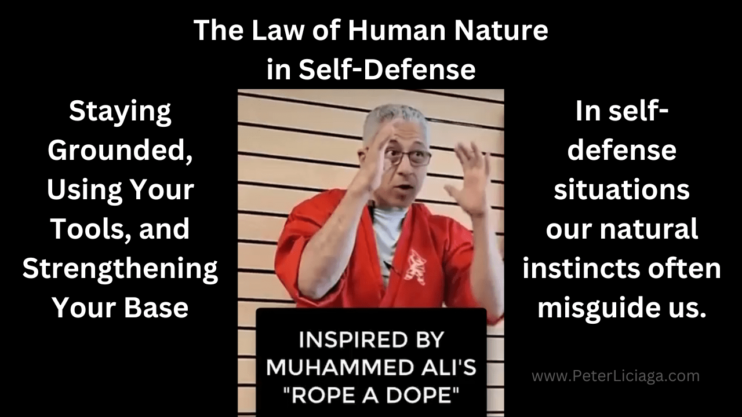In self-defense situations, especially on the ground, our natural instincts often misguide us. When attacked—thrown to the ground or knocked off balance—our human nature pushes us to turn away, exposing our back in an effort to scramble to our feet. While this instinct feels logical, it creates significant vulnerabilities, leaving vital areas exposed and compromising our ability to defend ourselves.
Through my research, deep conversations with key mentors, and personal experience, I’ve come to understand an alternative approach that aligns with the principle of base. When you find yourself on your back in a confrontation, staying grounded—keeping your back connected to the floor or a wall—can provide the stability and foundation needed for survival.
I learned this lesson most profoundly during a period when my hips had deteriorated, robbing me of much of my mobility and base. I couldn’t rely on quick movements or powerful transitions. Instead, I discovered the strength of adaptation. By keeping my back on the ground or against a wall, I found that we naturally possess the ability to improvise and overcome. It was a transformative realization—when we embrace our limitations, we unlock creative ways to regain control.
Your Back as a Strong Base: On the Ground or Against the Wall
Keeping your back connected—whether to the ground or a wall—reinforces your stability, enhances your awareness, and empowers your movements. Here’s how:
- On the Ground: Your back acts as a stabilizer, anchoring your body so you can use your arms, legs, and core effectively for defense, counters, and mobility. This positioning lets you face your opponent, monitor their movements, and protect yourself from further attacks.
- Against the Wall: When standing, your back against a wall can serve as a base to prevent you from being pushed backward or overwhelmed. It gives you the stability to manage distance, block attacks, and deliver counters while conserving energy.
This concept mirrors Muhammad Ali’s famous rope-a-dope strategy, where he used the ropes as a stabilizer to conserve energy, absorb pressure, and exploit openings in his opponent’s attacks. Similarly, your grounded or wall-based position becomes your “ropes,” allowing you to focus on timing, efficiency, and control.
Utilizing Your Tools: Defense, Counters, and Mobility
From this stabilized position, you can effectively utilize your “tools”—your hands, arms, legs, and core—to regain control and create opportunities for escape.
1️⃣ Defense and Counters:
- On the ground: Your legs act as barriers, your arms protect vital areas, and your core generates strength for sweeps and counters.
- Against the wall: You can use elbows, knees, and leverage to block strikes and create space for a counterattack or escape.
2️⃣ Mobility: Staying connected doesn’t mean being immobile.
- On the ground: Use your core and rotational movements to shift, pivot, and reposition.
- Against the wall: Shift side to side, keeping your opponent in front of you while maintaining a strong base.
3️⃣ Distance Control: Your tools help you manage the distance between yourself and your opponent. Whether using your legs to keep an attacker at bay on the ground or your arms to block strikes against the wall, distance management ensures you remain in control.
Life-Saving Principles and Concepts I’ll Be Teaching
When I return to the mats on January 6, 2025, these principles will be central to the lessons I share. Self-defense isn’t just about reacting; it’s about understanding your base, controlling the space around you, and using efficient strategies to protect yourself.
These teachings are deeply rooted in my 100-plus principles of martial arts, including:
- Base: Stability and control in every movement and position.
- Distance Management: Maintaining safe range while defending and countering.
- Efficiency: Using leverage, timing, and proper alignment to conserve energy and maximize impact.
- Resilience: Staying calm and focused, even when under pressure.
These lessons are for everyone—whether you’re a parent, grandparent, or someone entirely new to martial arts. The goal is to empower you with practical, life-saving skills while building confidence and awareness.
Building Your Base On and Off the Mats
This journey isn’t just about learning self-defense—it’s about creating stability, resilience, and confidence in every area of life. Whether on the ground, against a wall, or facing life’s challenges, the concept of base teaches us to stay grounded, face adversity head-on, and use the tools we already have to overcome obstacles.
When we come together on the mats this January, we’ll explore these principles step by step, ensuring that every participant feels capable, empowered, and connected.
Let’s embrace the mantra together: “You’re never too old, broken, bruised, or beat… AND it’s never too late to pursue a dream.”
Join me on this journey to rediscover strength, stability, and purpose. Together, we’ll learn, grow, and Live Strong.





